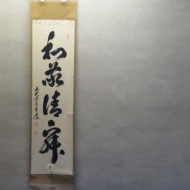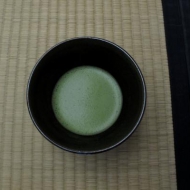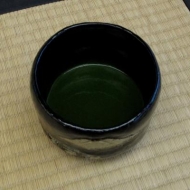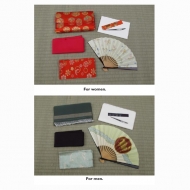Tearoom, Utensils, and Accessories

Tokonoma
Tokonoma (床の間, alcove): is a place to hang a scroll and to display flower arrangements or tea utensils.
Kakemono (掛物, hanging scroll) or Jiku (軸, scroll): is the most valued item in the tearoom. Normally, hanging scrolls display words and expressions from Zen Buddhism teachings. The host selects one that matches the theme of the tea gathering. This particular one reads, “Wa Kei Sei Jyaku (和敬清寂)” (“Harmony, Respect, Purity, and Tranquility”). It was written by Adachi Taido (足立泰道), the former chief Buddhist priest of the Daitoku-ji (大徳寺) Temple in Kyoto.
Hanaire (花入, flower container): Salt-fired style. Made by Jeff Guerrero. The flower is a white daffodil.

Usucha
There are two types of tea: usucha and koicha.
Usucha (薄茶, thin tea) uses one and a half scoops of tea powder along with a half ladle of hot water for one bowl.

Koicha
Koicha (濃茶, thick tea) uses three scoops of tea powder along with a quarter ladle of hot water for each guest.
Higashi
Higashi (干菓子, dried sweets) is served during thin tea procedure. It is served on a higashibon (干菓子盆, dried sweets tray). The colorful ones are pure sugar cubes made by Baikodo. Thin cookies are called funoyaki (ふのやき) made by Suetomi. The ginkgo leaf design on the funoyaki is a symbol of the Urasenke school, designating this as the Urasenke preferred sweets.
Chasen
During a tea procedure, the host uses the following utensils:
Chasen (茶筅, tea whisk): made with bamboo
Chashaku
Chashaku (茶杓, tea scoop): made with bamboo.
Hishaku
Hishaku (柄杓, ladle): made with bamboo.
Mizusashi
Mizusashi (水指, fresh water container): Aka-Shinoyaki (赤志野焼, red Shino ware) style with a lacquered lid. Used for thick tea. Made by Jeff Guerrero.
Mizusashi
Mizusashi (水指, fresh water container): Kyoyaki (京焼き, Kyoto ware) style with designs of tortoise shells and shikunshi (四君子)* flowers. Used for thin tea.
*Shikunshi, the four virtues in nature, is coming from Confucius ideology. Each flower corresponds to each season: orchid for the spring, bamboo for the summer, chrysanthemum for the fall, and plum for the winter. These designs of flowers and tortoise shells represent auspiciousness.
Chaire
Chaire (茶入, thick tea container): Katatsuki (肩衝, square-shoulder) style with an ivory lid. Made by Sasada Hitoshi (笹田仁史).
Natsume
| Natsume (棗, thin tea container): Koma (独楽, spinning top) style lacquered container. |
Chawan
| Chawan (茶碗, tea bowl): Kuroraku (黒楽, black Raku) style with a Mount Fuji design. Used for thick tea. Made by Sasaki Shoraku (佐々木松楽). |
Chawan
Chawan (茶碗, tea bowl): Kyoyaki (京焼き, Kyoto ware) style with green maple design. Used for thin tea. Made by Miyaji Eika (宮地英香).

Fukusa Basami
Both the host and guests carry the following items during chaji (clockwise from top right):
Kaishi (懐紙, packet of paper): used as a tray for sweets and to wipe the edge of the bowl.
Kashiyoji (菓子楊枝, sweet pick) and Kashiyoji-ire (菓子楊枝入れ, sweet pick case): for cutting sweets into small pieces for eating.
Sensu (扇子, folding fan): for greeting or viewing the utensils.
Kobukusa (古帛紗, small square silk cloth): for drinking thick tea or viewing utensils.
Fukusa (帛紗, square silk cloth): for purifying utensils. It is used by the host.
Fukusa basami (帛紗ばさみ, tea purse): for storing the above items.


